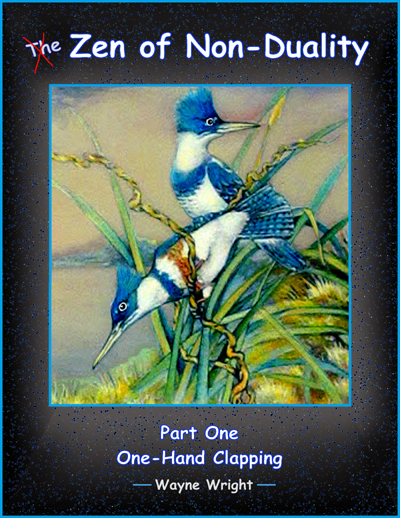
Zen of Non-Duality
Part One
One-Hand Clapping
That's what Zen is: Non-Duality
"Mind itself is not dualistic."
"...there are, Mahamati, those who have fallen into the dualistic way of thinking, being unable to comprehend the truth."
1 Master Huineng, Sixth Patriarch of Zen: "The Aim of Zen is Taking Hold of the Non-Duality of Truth".
2 Psychology of Zen: Our Original Holistic Mindset
3 Labels and Language: All Words, Symbols and Representations Cause Dualities
The heart of Zen is Buddha’s plain teachings on Non-Duality from the Lankavatara Sutra. The Lanka is the foundational text of Zen. It's the one written scripture brought to China from India, around the end of the Fifth Century, by Zen’s First Patriarch, Bodhidharma.
Master Huineng (638-713 J. Eno), the Sixth and final Patriarch of Zen who basically released Zen to the general public, confirms in Zen’s Platform Sutra that “Non-Duality is the aim of Zen”.

Perhaps the best known of all Zen teachings is Master Hakuin’s Eighteenth Century koan: "The Sound of One-Hand Clapping". This famous metaphorical riddle is a clear hit at the dead center of mental dualism versus the holistic mindset of Non-Duality.
Perusing the words of Buddha himself in the Lankavatara, one can focus on his actual teachings about what non-duality is. And we can read his hints about how to achieve a personal experience of non-dual awareness.
If there is a single point to Zen, as Master Huineng suggests, then this has to be it: Buddha’s simple teachings on Non-Duality from the foundational text of Zen.
Huineng, the Sixth Patriarch of Zen (638-713)
Buddhism is not dualistic. The aim of Zen is to take hold of this non-duality of truth. …Every possible form of dualism is condemned as not expressing the ultimate truth.
Brain/Mind Researcher, Author, Professor Robert Ornstein
[Humans have] two major modes of consciousness, one analytic, one holistic.
Cognitive Scientist, Professor Lay Leng Yeap
There is a need to recognize and accept the fact that there are two equally valid methods of acting upon, processing, perceiving, and storing information.
Zen scholar and translator D. T. Suzuki (1870-1966)
Our rationalistic way of thinking has no use in evaluating Zen. Zen’s uniqueness lies in its irrationality, or its passing beyond our logical comprehension.
Buddha (c. Sixth Century BCE), Lankavatara Sutra
There are, Mahamati, those who have fallen into the dualistic way of thinking, being unable to comprehend the truth.
The Lankavatara Sutra is the foundational text of Zen. The Lanka was importantly the only text that the First Patriarch, Bodhidharma, took with him when he emigrated from India into China, around the turn of the Sixth Century. After that, Zen’s earliest generations of Bodhidharma’s followers were known locally in China as the Lanka school. The type of Indian Buddhism they were learning from the Lanka was called Dhyana (mind only), which the Chinese pronounced Channa, and then Chan. Much later when their dharma was taken to Japan, that term morphed into the Japanese word Zen.

A main objective of the Lankavatara is Buddha’s desire to fully explain non-duality, and as he does that to explain his fundamental underlying Doctrine of the Two Truths. Basically Buddha’s “Greater Truth” (the first of the two) is simply unity or non-duality: the holistic mindset.
The Lankavatara is his cousin Ananda’s transcript, of a lecture series Buddha delivered in Sri Lanka. He went to teach there at the request of Ravana, the ten-headed Lord of Demons or Ashuras; and lord of the island fortress, Sri Lanka. With his ten heads, Ravana is the perfect poster-boy for duality, or multiplicity - isn’t he?
In Sanskrit: the word Prajna (holistic bodhi-mind) names the Greater Truth. And the word Vijnana (duality, comparison, analysis, rationality, etc.) is the Lesser of the two.
Holistic Prajna (or bodhi-mind) versus dualistic Vijnana. Prajna sees the forest as a whole, and Vijnana sees individual trees.
In the Lanka, Buddha is addressing both his host, ten-headed Ravana, as well as an interlocutor, the bodhisattva called Mahamati. Buddha warns them about the consequences of duality. His statement is perfectly clear. The holistic perspective of bodhi-mind is not available to those with a dualistic mindset.
Buddha, Lankavatara Sutra
There are, Mahamati, those who have fallen into the dualistic way of thinking, being unable to comprehend the truth.
Buddha, Lankavatara Sutra
The world cherishes dualism and is [thus] bewildered with wrong views.
Buddha, Lankavatara Sutra
Mind itself is not dualistic.
Buddha, Lankavatara Sutra
Transcendental knowledge is free from dualism.
When the dualistic discrimination is gotten rid of, there indeed is perfect knowing.
Buddha, Lankavatara Sutra
Words, Mahamati, are an artificial creation.
Buddha, Lankavatara Sutra
Words come into being, Mahamati, with discrimination as their cause.
Buddha, Lankavatara Sutra
By "discrimination" is meant that [mental process] by which names are declared. …Saying that this is such and no other, for instance, saying that this is an elephant, a horse, a wheel, a person walking, a woman, or a man, each idea thus discriminated is so determined.
Buddha, Lankavatara Sutra
The ignorant take hold of knowledge according to words, and are bound up like the silkworm with their own discriminations.
Master Linji (“Lin-gee” 810-866 J. Rinzai)
You are hindered by the labels and slogans you grasp. They obstruct your perception of objective truth.
Physics Nobel Laureate Niels Bohr
We are suspended in language in such a way that we cannot say what is up and what is down.
James Gleick on Feynman’s physics
Our knowledge of things is inextricable from the language we use. The words and analogies from which we build our explanations are culpably linked with the things explained.
Sixth Patriarch Huineng (638-713)
Whatever can be named leads to dualism. …As long as there is a dualistic way of looking at things there is no emancipation.
The bodhisattva Manjusri in the Vimalakirti Sutra
Non-duality is no speech, no explanation, no direction, and no representation, leaving behind all questions and answers.
Buddha, Lankavatara Sutra
The highest reality is to be attained by the inner realization of noble wisdom [prajna]; it is not a state of word-discrimination. …Therefore, Mahamati, you must try to keep yourself away from the various forms of word-discrimination.
Master Nanyueh (677-744 J. Nangaku)
If you say what a thing is, then you’re already wrong.
Separating from words is self-liberation.
Buddha, Lankavatara Sutra
Mahamati, be not engrossed in the word-teaching.
Buddha, in his Flower Sermon, Gateless Gate, Koan #6
I have the eye of the true teaching, the heart of Nirvana, …the ineffable stride of Dharma. It is not expressed by words.